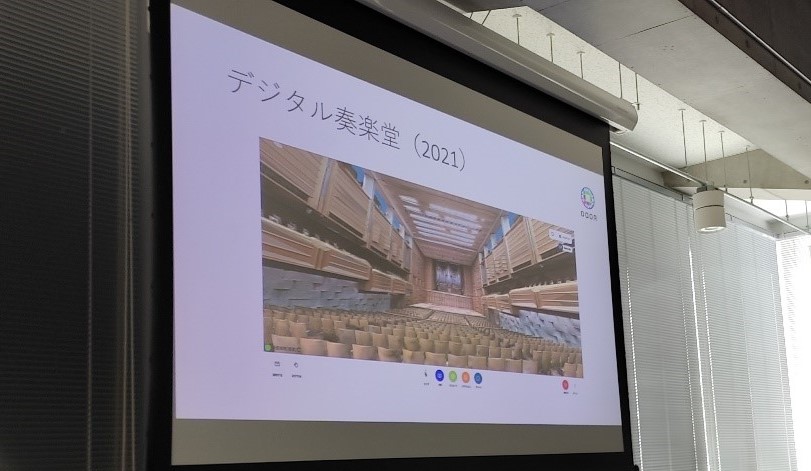Activity Digital Ohashi Campus2023.3.16

Research Director:
Associate Professor Tomo Inoue, Faculty of Design
Keywords:
VR, AR, XR
This project hosted a study group of researchers and practitioners of VR, AR, and XR to develop a digital platform allowing Ohashi Campus to be experienced as a digital twin, to virtually introduce the research, works, lectures, public classes, symposiums, exhibits, concerts, games, and other school events produced by the instructors and students of the Faculty of Design. Lectures at the event included talks by members of the Tokyo University of the Arts (Geidai below), including “Digital Education at Geidai” by Tomoya Matsuura and “Digital Geidai” by Ryohei Akita, and a talk called “From Architecture to the Metaverse” by Kanna Banjo of Idiomorph.
Matsuura spoke about how the digital twin of the Tokyo University of the Arts was being used since its online launch, highlighting the Digital Ueno-no-Mori (via VRChat/Cluster) that served as the beta version of Digital Geidai, online exhibits, music content streaming (via Vimeo etc.), streaming the entrance and graduation ceremonies in a virtual space (via Mechaverse), and special lectures and classes. Digital Ueno-no-Mori involved scanning the entire Ueno Park in 3D and releasing it via VRChat and Cluster. Aiming to be a platform for experience and exchange in Ueno Park as a cultural and tourist hub online, in addition to the real world, the platform is used to introduce content from each of the park’s facilities and as a showcase for the young talent at Geidai who will lead the next generation. For the online exhibit, a digital version of the Chinretsukan Gallery of the Tokyo University of the Arts was produced as a 3D model to exhibit student works, screen animated films, and host talk events. It was explained that available features depend on the platform being used to host the digital twin, such as Mozilla Hubs, NTT DOOR, Cluster, and VRChat, as well as on the viewing device, such as a browser, smartphone, VR headset, or app, and that the platform used is selected each time according what needs to be shown or the type of exchange. Next, Akita spoke on the details of a variety of projects for digital spaces, including 3D digital archives and fly-through videos of point cloud data such as Digital Geidai, Digital Geidai Beta, Digital Sogakudo, Digital Chinretsukan, Digital Hakudo Station, the former Miyakonojo Civic Hall, and the Nakagin Capsule Tower. He explained that the selection of data processing methods and platforms should depend on goals, including how to obtain the point cloud data, how to process it to generate the finished model, what level of completeness to aim for, and what platform to use to release that completed model. He explained that platforms such as VRChat, Cluster, Mechaverse, Styly, NTT DOOR, and Matterport are all useful, each has their strengths and weaknesses. He then introduced the complete process for releasing virtual spaces, from generating point cloud data from 3D scans, creating the mesh, building the world in Unity, and releasing it on DOOR or Mechaverse, using examples including Digital Sogakudo, Digital Chinretsukan, the small hall of Tokyo Bunka Kaikan, and the auditorium at the Tokyo Metropolitan Art Museum. He also introduced a variety of gimmicks for enjoying the virtual experience of the worlds, such as using an avatar to take selfies or scenic photos in the virtual space. He also spoke about the future outlook, including world resolution and gimmicks for further enjoyment of virtual worlds, issues such as rights involved with student works, and the spread of data through scanning technologies in worlds geared toward releasing content such as works and events.
Kanna Banjo of Idiomorph covered the definitions of terms such as the Metaverse, VR, and AR, spoke of the latest trends in the VR industry, including blockchain, and introduced several Metaverse spaces he is working on. He also spoke about the potential of the Metaverse. Topics he touched on include that while there are fewer limitations to metaverse design than for the architecture of physical spaces, the greatest limit is rendering load. Another was the importance of spatial UX design because users operate avatars to navigate the metaverse spaces, and the need for design elements that had previously been unnecessary in architectural design, such as consideration of sound, interaction, UI, avatar, and narrative design elements. He added that planning and design was inseparable for metaverse spaces to the specificity of the purpose thereof, and touched on the elimination of limits of distance, body, language, and time, and the relationship between people and space.
Given these talks, we were able to consider in depth how the Digital Ohashi Campus should be in the post-Covid era.
This research received a small grant in FY2022 from the Center for Designed Futures of Kyushu University.
